Qinhuai River
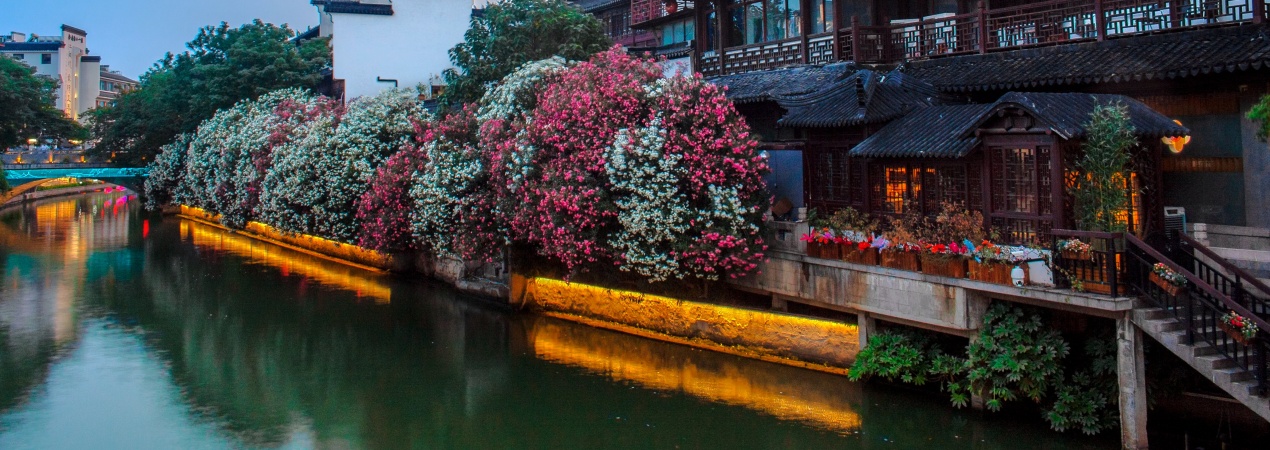
The Qinhuai River is a right-bank tributary of the lower Yangtze River in China. Formerly called Longzangpu, it was known as Huai Shui from the Han Dynasty and renamed Qinhuai after the Tang Dynasty. Mostly flowing through Nanjing, it is the largest regional river in the city, with abundant water and biological resources. Historically, its role in navigation and irrigation nurtured Nanjing’s ancient civilization, earning it the title "Mother River of Nanjing." It has witnessed Nanjing’s long history, serving as the cradle of the city’s brilliant historical civilization, and was once renowned as "China’s No.1 Historical and Cultural River."
- Chinese name:秦淮河 Qín Huái Hé
- Recommended Duration: 1-2 hours
- Entrance Fee: Free
- Opening Hours: All day
- Best time to visit: March to April
- Address: Outside the Tongji Gate in the southeast of Nanjing City, near Jiulong Bridge
-
How to get there:
By Metro: Take metro Line 3 to Fuzimiao Station, exit from 1 and 2, and walk 5-10 minutes to the Qinhuai River
By Bus: Take bus 4, 7, 40, 44 and other buses to Fuzimiao Station or Sanshan Street station, then walk to the river
Highlights of Qihuai River
Qinhuai River Night Cruise
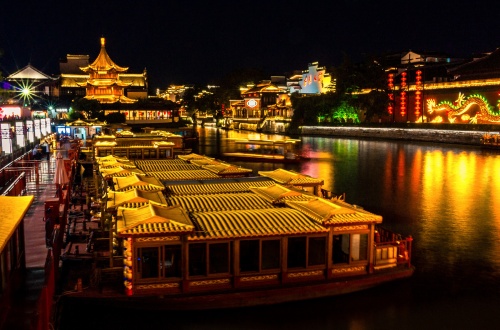 Qinhuai River Night
Qinhuai River NightThe Inner Qinhuai River is the best part of the Qinhuai Scenic Belt. It is 9.6 Chinese miles long, and people used to call it the "Ten-Li Qinhuai River". At Panchi Wharf (No. 121, Gongyuan Street near Confucius Temple), tourists can get on boats. When they take the boat tour, classic works like Upper Yuan Festival Lanterns and Prosperity of the Southern Capital show up one by one. Well-known poems and traditional shouts also float to their ears. If you take the west-line boat tour, you can enjoy the "Dreamlike Qinhuai "boat movie. A professional team makes the music story scene commentary inside the boat. The glass walls on both sides of the boat are used as mobile screens for the performance projections. This mixes river cruising, movie watching and interaction into one immersive experience. It brings back the prosperous look of the "Ten-Li Qinhuai River" again.
Qinhuai Lantern Festival
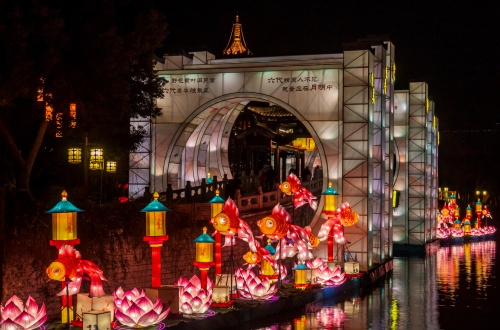 Qinhuai Lantern Festival
Qinhuai Lantern FestivalThe Qinhuai Lantern Festival is one of China's most influential traditional lantern festivals. Originating in the Six Dynasties period and flourishing in the Ming Dynasty, it has a history of over 1,700 years and was included in the national intangible cultural heritage list in 2006. Every year from the Lunar New Year to the Lantern Festival (from the 23rd day of the 12th lunar month to the 18th day of the first lunar month), the area around Nanjing Confucius Temple and Qinhuai River turns into a brilliant "paradise of lights", attracting millions of tourists to enjoy the lanterns. Centered on Confucius Temple, the festival extends to areas like Laomen East and Bailuzhou Park, displaying hundreds of large lantern sets. Traditional palace lanterns, modern light effects and the water scenery of Qinhuai River complement each other. There are not only auspicious lantern sets with themes like "two dragons playing with a pearl" and "carp leaping over the dragon gate", but also interactive devices integrated with a sense of technology. Tourists can take painted boats for a night tour to experience the poetic scene of "Qinhuai River in the sound of oars and light of lanterns", or take part in folk activities such as lantern riddle guessing and lantern making.
Tips:The Qinhuai Lantern Festival is usually held from the 23rd day of the 12th lunar month to the 18th day of the first lunar month every year (from the Chinese Lunar New Year to the Lantern Festival).
Confucius Temple
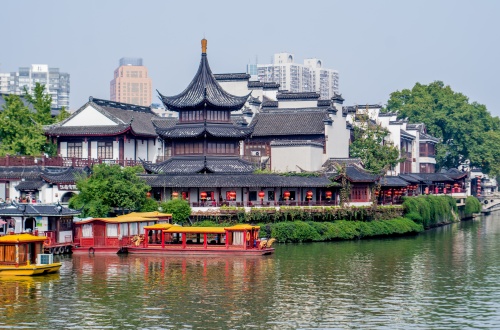 Confucius Temple
Confucius TempleConfucius Temple is a landmark building of the Qinhuai River Scenic Belt. It houses a huge portrait of Confucius and The Map of Confucius' Life Stories, among other items. As night falls, the area around Confucius Temple is lit up with decorative lanterns, and the magnificent buildings glow with splendor. Dancers in elegant traditional costumes often make stunning appearances, performing shows like "The Cultural Center of the World" and "Wisdom Weaved in Clouds". These performances bring the prosperity of Jinling (Nanjing's old name) during the Six Dynasties to life right before visitors' eyes. Wende Bridge is also a classic photo spot at Confucius Temple. Standing on the bridge, you can take in a panoramic view of scenic spots including moored cruise ships, the double-dragon stone wall, Jiangnan Examination Hall and Zhuangyuan Post Pavilion. The 3rd stone baluster on the bridge is the "golden spot" for taking photos of the "Qinhuai Moon Split" scene.
Zhonghua Gate Light Show
As dusk falls, the large-scale immersive light sculpture show "Heartprint · Zhonghua Gate" begins. Gorgeous light and shadow weave into stunning scenes, while the massive city wall transforms into a huge "screen" — the entire Zhonghua Gate Barbican turns into an immersive theater. The show consists of three chapters: "The Origin of Zhonghua Gate", "The Dignity of Zhonghua Gate" and "The Glory of Zhonghua Gate". It uses the three gates of Zhonghua Gate Barbican to present three scenarios and tell 12 stories. As the audience moves to different spots to enjoy changing views, they can catch a glimpse of Nanjing's city wall history through Zhonghua Gate's 600-year past. They can also see various intangible cultural heritage elements, such as Nanjing Baiju (a local folk art form), traditional opera and dance.
Educational Value
The Qinhuai River is the "Mother River" of Nanjing's culture. Especially the river basin centered on the "Ten-Li Qinhuai River", it is an epitome of Jiangnan culture during the Ming and Qing dynasties. During the boat tour, scenic spots along the river such as the Confucius Temple ancient building complex, Li Xiangjun's Former Residence and Wuyi Lane, as well as intangible cultural heritage performances like Kunqu Opera and Pingtan (story-telling and ballad-singing in Suzhou dialect) that may be staged on the boat, allow visitors to intuitively experience China's ancient imperial examination culture and understand the impact of the imperial examination system on ancient Chinese society. It also enables visitors to immerse themselves in the prosperity of the "Ten-Li Beaded Curtains" along the Qinhuai River during the Ming and Qing dynasties and experience the traditional Jiangnan urban life.
Activities to do at Qinhuai River
Experiencing evening shows at Gan Xi's former residence: Evening shows at Gan Xi's Former Residence are staged under the cover of night. Visitors can watch performances such as water screen shows, guzheng playing, and Nanjing Baiju (a local folk art form) here. The fan-shaped water show between the pool and rockery uses the water screen as a "stage" and blends seamlessly with the surroundings of Gan Xi's Former Residence. There are different performance contents in five areas including Jindi Building, South Gate Lawn, and the pavilion, allowing visitors to feel the charm of traditional culture.
Drop us a line and we'll connect you with the top China expert in no time!
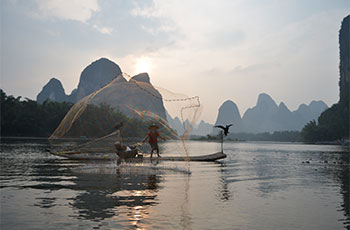 Li River
Li River 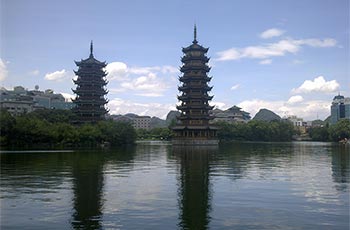 Two Rivers and Four Lakes Scenic Spot
Two Rivers and Four Lakes Scenic Spot 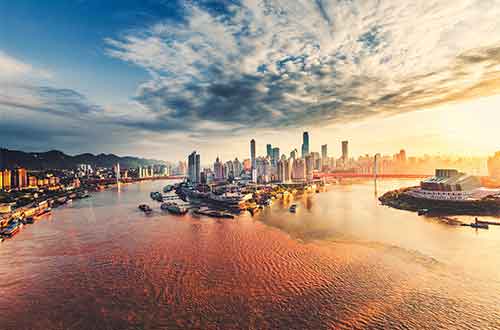 The Yangtze River
The Yangtze River 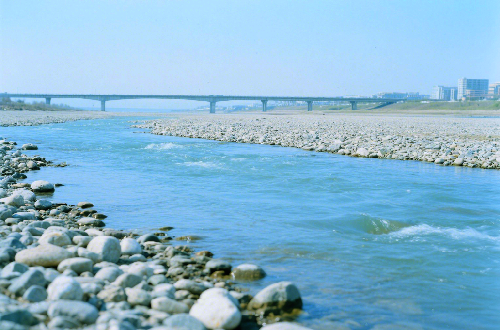 White Jade River
White Jade River